When you think of Serengeti National Park, the word “iconic” likely comes to mind. If you’ve ever dreamt of embarking on a safari across the vast African continent, chances are you’ve envisioned the golden savannahs of the Serengeti. Known as a place where the land stretches on forever, the Serengeti stands out as one of the top wildlife destinations and one of the most remarkable natural wonders on our planet.
Few places on Earth boast such rich habitats, unspoiled landscapes, and exhilarating wildlife experiences. The Serengeti is home to the greatest wildlife spectacle on the planet, featuring some of the largest concentrations of animals and birds, along with a variety of safari activities. The endless plains of the Serengeti are truly a marvel.
For a unique safari experience in Tanzania, on the land where humanity is believed to have originated, there is no better place than the Serengeti.
TOURS & SAFARIS : Tanzania Luxury Safari, Tanzania Day Tours, Tanzania Walking Safaris, Honeymoon Safari, Experience Tanzania, Zanzibar Beach Holidays, The Great Wildebeest Migration, Tanzania Safari Packages
IMPORTANT : Tanzania safari cost, Where and When To Go Tanzania Safari, Things to do in Tanzania
Location: Northern Tanzania
Area: 14,763 square kms
Established: 1951
Number Of Visitors: 350,000 per year
Famous For: The Wildebeest Migration
Country: Tanzania
Region: Africa
Located in the northern region of Tanzania, the golden plains of Serengeti National Park cover nearly 15,000 square kilometers. The park lies entirely within the northeastern part of the Simiyu region and the eastern Mara region. The landscapes of the Serengeti Ecosystem are incredibly diverse, ranging from savannahs and open grasslands to hilly woodlands and riverine forests. This variety is due to the extreme weather conditions, particularly the combination of heat and wind.
The habitats of the Serengeti are believed to have originated from volcanic activity, which shaped the ecosystem by adding craters and mountains to the landscape. The Mara River, flowing from the Kenyan highlands to Lake Victoria, is the only river in the Serengeti ecosystem that flows permanently. This river is famous for its dramatic migration crossings.
Over 300 species of plants are recorded in the Serengeti, including 15 alien species that are distributed throughout the park. The Serengeti is particularly famous for its acacia trees and sausage trees, which are easily spotted during game drives across the vast savannahs from your safari vehicle.
Woodlands are commonly found in the northern region of the Serengeti, where the landscape is covered by hills. The Western Corridor is characterized by lush savannahs dotted with acacia trees, and the Grumeti River flows through this area.
The flora of Serengeti National Park is not just visually stunning; it is essential for the wildlife that inhabits the park. Without this rich plant life, a safari in the Serengeti would be a completely different experience. The scenic views would be replaced by dry, barren lands, highlighting the crucial role that the park’s lush greenery plays in sustaining its vibrant ecosystem.
Even though Serengeti is situated in a rather remote corner, accessing the park is fairly easy. Your most suitable option would be to fly into the town of Arusha. There are seven airstrips in the park, so it’ll be very convenient.
Or you could go another way, which is to book a 4WD safari vehicle from Arusha to Serengeti. This way you’ll get an opportunity to visit a couple of other parks along the way. Naturally, you can also choose to combine both these options and book a one-way overland safari and fly back to Arusha.
Getting To Serengeti National Park by air is the most convenient and quick option. You will have a couple of choices if you want to access Serengeti by air.
We recommend Kilimanjaro International Airport as your point of entry. Located between the towns of Arusha and Moshi, it is approximately 320 km from the southern entrance of the Serengeti.
For international flights, we suggest considering airlines such as KLM Royal Dutch Airlines, Kenya Airways, Turkish Airlines, and Ethiopian Airlines. Additionally, Emirates and British Airways offer flights to Dar es Salaam (DAR). If you choose this route, you may need to stay overnight at a hotel and take a domestic flight the following day.
All regional flights are operated by local airlines like Coastal Aviation and Grumeti Air. Flying from Arusha Airport (ARK) and Kilimanjaro International Airport (JRO) is the most favoured route.
Another quick and convenient option to get to Serengeti is booking a private or charter flight. Some of the luxury lodges have their private airstrip and they can arrange a direct scheduled or private charter flight from Arusha Airport or Kilimanjaro International Airport (JRO).
If you’d like to skip taking a flight and take the road less travelled, then this option is for you.
You can get to Serengeti National Park by booking drive-in safaris. They usually start in the town of Arusha. From there, it will take about 7.5 hours to drive to the Serengeti.
Self-drive safaris are possible but not recommended. This is because it takes utmost care and careful planning to drive by yourself through the park. A 4WD safari vehicle is necessary to access the roads throughout the year. You can get fuel at the Seronera region in Southern Serengeti.
There are four primary entry and access points in the Serengeti. They are referred to as gates.
This is the main access point of Serengeti National Park. The gate is situated around 45 km. from the Seronera region. Opening hours are from 6.00 am to 6.00 pm.
This gate is the main access point for the Western Corridor region. Ndabaka Gate is located around 145 km. from the Seronera region and it takes about 1.5 hours to drive from Mwanza to the gate. Opening hours are from 6.00 am to 6.00 pm. Though keep in mind that the last time of entry is 4.00 pm.
This access point is located in the northeastern region of the Serengeti. The opening hours are the same as the above two. I.e. From 6.00 am to 6.00 pm.
TThis access point of Serengeti National Park is located just south of the Kenya-Tanzanian border. It lies in a remote area of the park, thus the gate is rarely utilized.
The gate is situated on the northwestern border of the Serengeti. Fort Ikoma Gate is easily accessible from the Seronera region with the drive taking about an hour.
Located in the southwestern region of Serengeti, this access point is rarely used. The gate is just six km. from the Grumeti Game Reserve and is close to the Kirawira B airstrip.
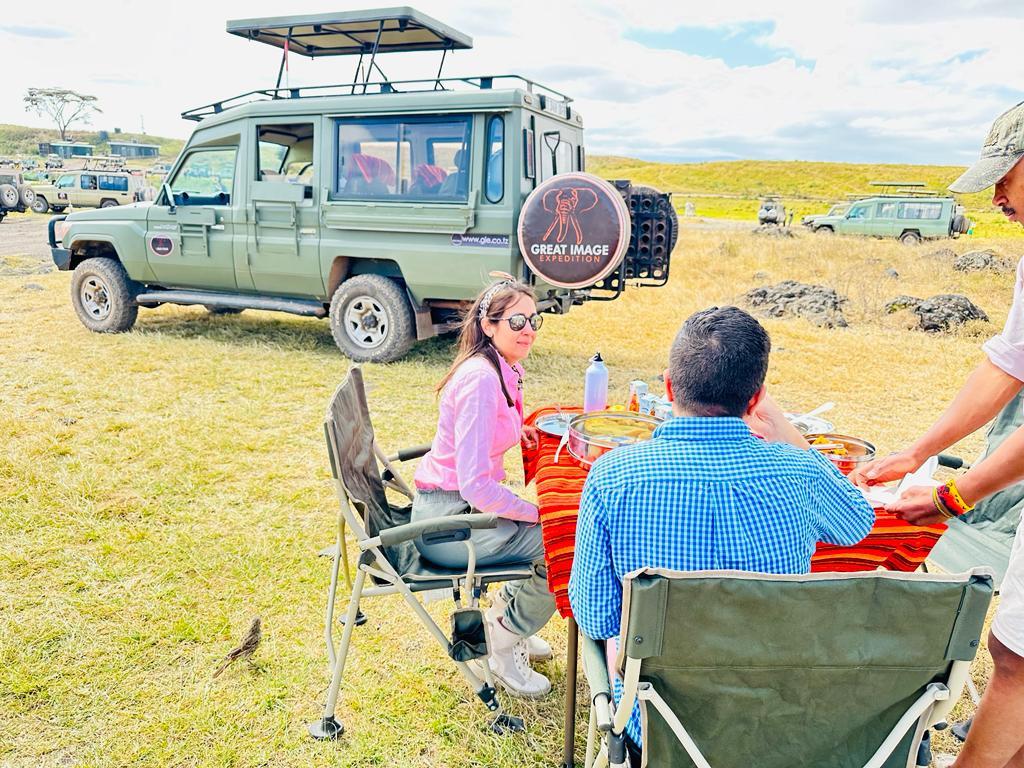
Imagine never knowing about the Great Wildebeest Migration! Yet, this was once the case. In the early 1900s, explorers described the unbelievable plains of the Serengeti and the enormous numbers of animals found there, which seemed too amazing to be true. This remained the belief for several years until the first photographs of the region were published in the 1920s, leaving everyone stunned by the spectacle.
In 1930, an area of over 2,000 square kilometers was designated as a game reserve, now known as the Southern and Eastern Serengeti. The national park itself was established in 1951, with its headquarters on the rim of the Ngorongoro Crater. The original park included what is now the Ngorongoro Conservation Area, which was separated from the park in 1959 to allow the native Maasai communities to live and graze their cattle without interference.
In 1961, the Masai Mara National Reserve was established in Kenya. Four years later, a permanent corridor called the Lamai Wedge was created between the Mara River and the Kenya border, allowing herds to migrate from the Serengeti savannahs to the Loita plains in the north. The Maswa Game Reserve was also established in 1962.
What was once an undiscovered treasure is now renowned worldwide! The Serengeti was among the first places to be declared a UNESCO World Heritage Site in 1981. Now, you can experience the pleasure of exploring the endless plains of the park on safaris to Tanzania.
The extensive ecosystem of Serengeti National Park has many seasonal differences when it comes to weather and climate. The park experiences a cool and dry season from the months of May to August, a warm dry season in September and October, and a wetter hot season from November to April.
Everyone has a belief that Africa is mostly a very hot place, but the temperatures of the Serengeti are moderate and pleasant. It rarely gets uncomfortably hot and temperatures drop during the nighttime and early mornings.
The minimum and maximum temperatures vary according to the seasons. The wet season is generally considered to be the warmest. The following chart will show the average temperatures of Serengeti in more detail.
| Months | Minimum Temperature (in Celsius) | Maximum Temperature (in Celsius) |
| January | 26 | 29 |
| February | 16 | 29 |
| March | 16 | 29 |
| April | 16 | 28 |
| May | 15 | 27 |
| June | 15 | 26 |
| July | 14 | 26 |
| August | 15 | 27 |
| September | 15 | 28 |
| October | 16 | 28 |
| November | 16 | 28 |
| December | 16 | 28 |
GOOD TO KNOW: The average maximum temperatures vary based on elevation: from 15 Celsius around the crater highlands to around 30 Celsius near Lake Victoria.
Two rainfall periods govern the climate of Serengeti National Park. The first to break the grip of the dry season is the short rains, in November and December. Long rains follow soon in the period from March to May.
Though it rarely rains for a whole day, it does rain on most days. These rains turn the landscapes of the plains into vibrant green. This is why the season is referred to as the green season.
| Month | Amount of Rainfall (in mm) |
| January | 80 |
| February | 100 |
| March | 135 |
| April | 160 |
| May | 90 |
| June | 25 |
| July | 15 |
| August | 30 |
| September | 60 |
| October | 70 |
| November | 115 |
| December | 105 |
SOME INSIGHTS: Sometimes the rains fuse into a single extended period. This mainly happens in the northern region of the park. Also, the short rains may not occur entirely, particularly in the southeast region of the Serengeti.
The density of wildlife in Serengeti National Park is among the highest on the planet, making safari experiences spectacular year-round. However, the optimal time to visit is during the dry season, from January to February and June to October, when the vegetation is thinnest and spotting animals is easier.
That said, visiting outside the dry season is by no means inferior. The wet season (from November to May) is considered the best time for birdwatching in the Serengeti, and the fewer crowds make for a more exclusive safari experience.
Knowing the right time to visit the Serengeti is crucial for witnessing one of the last remaining natural wonders of the world—the Great Migration. Winter is the best time to see these supersized groups in the Southern Serengeti, while June and July are ideal for the migration in the Western Corridor. August and September are perfect for witnessing the herds in the northern section of the park.
Below is a monthly breakdown of visiting Serengeti National Park to help you decide when to visit based on the experiences you seek.
January to March – Lush Landscapes, Calving Season, and Budget Travel!

There are two sides to the same coin. And this is also true for the two seasons of Serengeti. Both the dry and wet season have their benefits and drawbacks. So, to provide you with a complete understanding of this, the followings are the pros and cons of the dry and wet seasons.
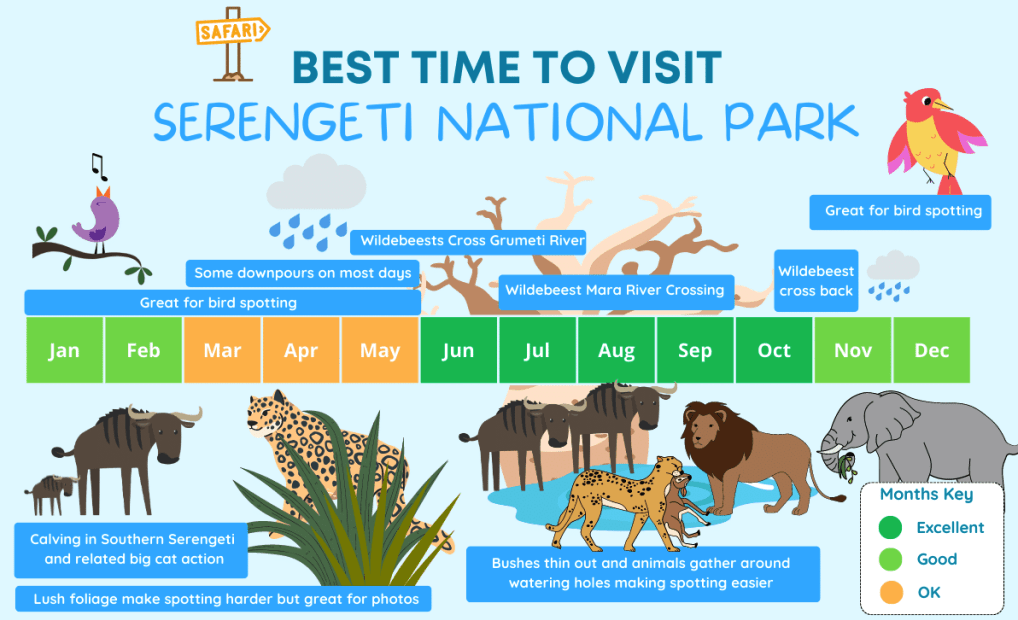
Pros | Cons |
The thinner vegetation allows for seamless game viewing. | The park can get crowded in the dry season, particularly in the Seronera region. |
Animals gather around the watering holes. | The temperature tends to get very cold at night. To counter this, we suggest you bring a few pairs of warm clothing essentials. |
Bright days with lots of sunshine. This will make photography easier and game drives pleasant. |
|
There are fewer mosquitoes, so the chances of contracting malaria are very low. |
|
More convenient time to see the Great Wildebeest Migration. |
|
Pros | Cons |
This is a great time to see the calving season and the resulting predator action. | The months from March to May are the peak of the wet season. |
The landscapes are wonderfully vibrant. | The park can get fairly crowded from January to March, mainly in the Seronera region. |
Fewer tourists and discounted rates. | |
The birdwatching experience is fantastic with the presence of many migratory birds. |
Thus, you’re aware of what the seasons and months of Serengeti National Park offer. Now, you can visit the park based on your preferences and what you’d like to experience.
Choices on top of choices – that’s the challenge when packing for Safaris in Tanzania. Narrowing it down to the essentials is key, but identifying these essentials can be the main battle. To help you, here’s a comprehensive Tanzania Safari Packing List. Ensure you include all the items below in your checklist.
Remember these words when packing for Tanzania safaris: Color and Comfort. Moisture-wicking clothes and breathable fabrics are highly recommended. Here’s a list to get you started:
Avoid bright-colored clothes while on safaris in the Serengeti. Earth tones and neutral colors are ideal. Since laundry services are available at most Serengeti accommodations, you can avoid overpacking.
Essential gadgets for safaris include a camera, binoculars, adapters, and a high-capacity power bank. If you plan to go on night safaris, a headlamp or flashlight is recommended.
Pro Packing Advice:
Ensure you have all the necessary documents before embarking on your Serengeti Safari journey. These include:
In Tanzania, there’s a risk of malaria in some areas. Therefore, take all essential safety precautions such as anti-malaria tablets and a DEET-based mosquito repellent.
Equally important is knowing what not to pack for your Serengeti safaris. Here are some items to leave behind:
By following this guide, you’ll be well-prepared for an unforgettable safari adventure in Tanzania!
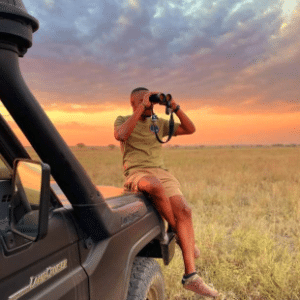
The entire ecosystem of the Serengeti is a region of amazing biodiversity. If you want to have a safari in the park, you must know what things all the different areas have in store. So, the following are the primary five safari areas in Serengeti National Park.
The southeastern area of Seronera is the centre of wildlife viewing in the wet season, from December to April. Huge herds of wildebeests gather here in the wet season. This makes for amazing predator action and Seronera is widely known as the predator capital of Tanzania.
Lion sightings along the Seronera River are almost guaranteed. The riverbanks are also home to some of the densest populations of leopards. They can be seen on top of the sausage trees. Some patience combined with a bit of luck may also result in the sight of tree-climbing lions.
The region is also home to black rhinos and many herbivores. The plains around the Kamuyo Hills are a great site to witness cheetahs, elephants, and spotted hyenas.
The southeastern area of Seronera is the centre of wildlife viewing in the wet season, from December to April. Huge herds of wildebeests gather here in the wet season. This makes for amazing predator action and Seronera is widely known as the predator capital of Tanzania.
Lion sightings along the Seronera River are almost guaranteed. The riverbanks are also home to some of the densest populations of leopards. They can be seen on top of the sausage trees. Some patience combined with a bit of luck may also result in the sight of tree-climbing lions.
The region is also home to black rhinos and many herbivores. The plains around the Kamuyo Hills are a great site to witness cheetahs, elephants, and spotted hyenas.
For an authentic Tanzania safari experience, the Ndutu Plains are an ideal destination. These vast open grasslands are home to numerous animals, including giant herds of wildebeests and zebras during the wet season.
The Ndutu Plains are also the site of the calving season, where wildebeests give birth from January to March. The woodlands around Lake Ndutu provide shelter to a wide variety of birds, with Fischer’s lovebird being one of the most fascinating sights.
The southeastern plains are dotted with clusters of kopjes, which are habitats for wildlife such as the klipspringer, rock hyrax, leopards, and raptors. Lions also use these kopjes as vantage points to survey the plains. The Simba Kopjes is an excellent spot to see these majestic kings of the golden savannahs.
In the western reaches of the Serengeti, there lies an undiscovered gem – the Grumeti Game Reserve. The reserve is located in a beautiful and remote corner of the park. And because of this remoteness, the game-viewing experience is heightened.
The number of people who can stay in the camps surrounding the region is limited. So, as a result, the number of crowds is fewer, which is great news for you if you want a private safari experience.
Wildlife viewing in the reserve is great throughout the year. The savannahs in the southern region of the Grumeti River support a range of wildlife. They include wildebeests, giraffes, zebras, and lions. The remote surroundings north of the river are a great place to see cheetahs.
The northern plains of the Serengeti are undiscovered, beautifully scenic, and remote as compared to the plains of the Southern Serengeti. The region stretches from the Lobo Hills to the Seronera and is characterized by rolling green hills. This landscape is a pleasant departure from the flatter plains of the southern region.
Because the northern plains are much denser in terms of vegetation, animals are harder to spot. But the northern plains have fewer crowds, so it should certainly be considered visiting, despite the drawbacks.
You may even get to experience a game drive without another vehicle in sight. Just picture cruising across the landscape of open grasslands with some dense woodlands sprinkled in! A serene experience for sure.
The Serengeti Western Corridor is an expanse of land following the course of the Grumeti River from Central Serengeti out towards Lake Victoria. The foremost feature of the Western Corridor is a pair of rivers – the Grumeti River and the Mbalageti River.
The habitat of this region is mostly a combination of woodlands, dotted with dense whistling thorns and open savannahs. These habitats are home to a substantial range of wildlife like elephants, wildebeests, lions, zebras, and several other species of antelopes.
The Western Corridor is a wonderful portion of the Serengeti that supports a spectrum of resident wildlife all year round. From May to July the migrating herds pass through this region.
A place where the endless plains meet the horizon and travelers witness boundless wildlife—this is the charm of Serengeti National Park. The primary reason to visit the Serengeti is to experience wildlife in an unspoiled, natural environment, and rest assured, you will achieve exactly that!
The golden savannahs of the Serengeti are considered one of the greatest wilderness regions on the planet. The clear transition from rich flat soils to hilly terrains results in a diverse range of vegetation and habitats across the park.
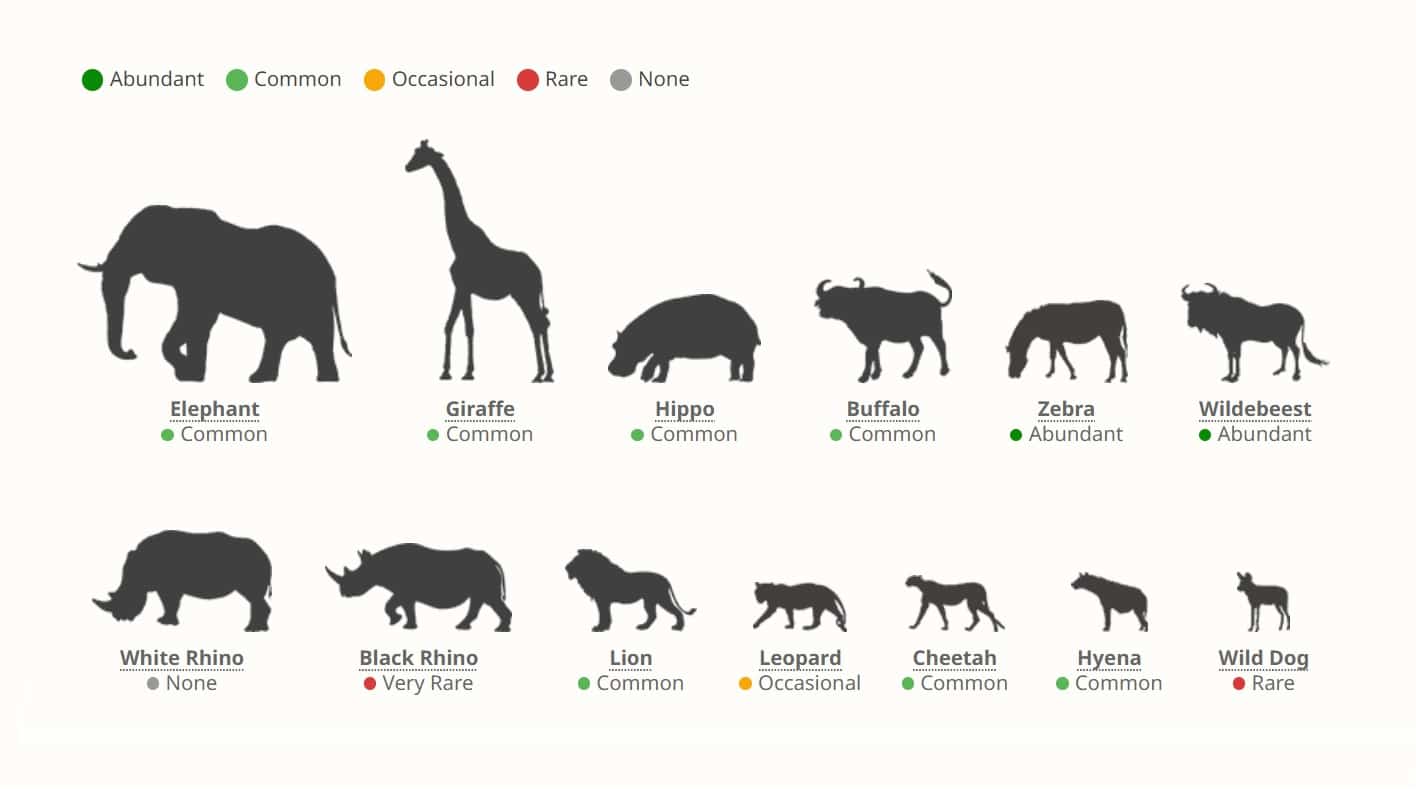
Riverine Forests: A distinctive habitat in the Serengeti, these forests are favored by crocodiles and hippos. You’ll also find long-necked giraffes and various hoofed animals such as zebras, topis, impalas, elands, and Grant’s gazelles.
Big Cats: All the big cats are easily spotted in the park. Lions are abundant and can be found throughout the Serengeti. Cheetahs roam the southeastern grasslands, while leopards are often seen lounging atop acacia trees along the Seronera River.
The Big Five represent the pinnacle of Tanzania safaris: cape buffaloes, lions, leopards, elephants, and rhinoceroses. The term “Big Five” was coined by colonial hunters, referring not to the size of the animals but to the difficulty of hunting them. Seeing these magnificent creatures in their natural habitat is an unforgettable experience.
The Serengeti is home to the largest population of lions in Africa, with around 3,500 individuals in over 300 prides. Lions are social animals, living in prides where females do most of the hunting. Look for them snoozing under trees, especially the tree-climbing lions in the Seronera region.
Known for their grace and striking fur, leopards are elusive and excellent at camouflage. They are often seen in the Seronera region, lounging on sausage trees.
Buffaloes can be found around various waterholes in the park. Their intense gaze is mesmerizing, and with herds roaming the Serengeti, sightings are common.
Over 7,000 elephants roam the Serengeti, from the plains to the dense woodlands. These gentle giants are often seen near waterholes, even close to some Serengeti accommodations.
Although rhino populations in the Serengeti are lower than in other African destinations, sightings are possible thanks to conservation efforts. Female rhinos give birth only once every five years, making them one of the rarest species to spot.
Even if you’re not a birdwatching enthusiast, the Serengeti’s avian diversity will captivate you. The park is home to over 500 bird species, including the secretary bird, Kori bustard, and the colorful Fischer’s lovebird. The Serengeti-Mara ecosystem hosts five endemic bird species found nowhere else on Earth.
For the best birdwatching, visit between November and April, when resident species nest and migratory birds from North Africa and Europe are present. Combining your Serengeti trip with a visit to Lake Manyara enhances the birdwatching experience.
Though stinging and biting insects are not popular, they play a critical role in the Serengeti ecosystem. Guides can explain the importance of insects like grasshoppers, termites, moths, butterflies, dung beetles, and ants in maintaining the ecological balance.
The race of life for the herbivores of the Serengeti! This is the greatest show on our planet, and you’ll get the opportunity to witness this stunning spectacle on Safaris in Serengeti.
The expedition of the main cast in the migration – the two million wildebeests begins in Southern Serengeti. This happens after the mass calving season, in the months of January and March. This is the favourite season for all of the safari-goers and the atmosphere during this time is filled with new life and exciting action.
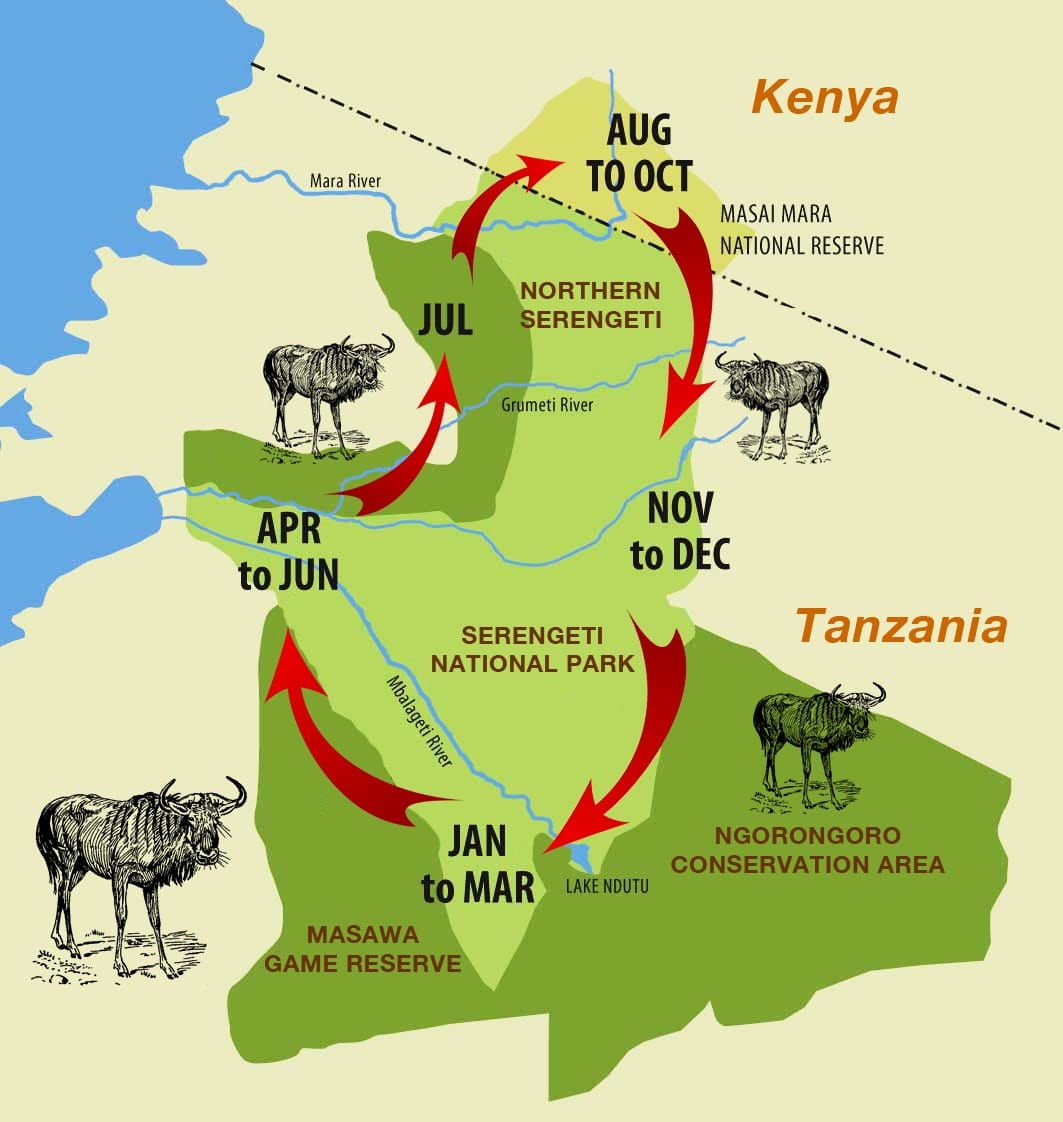
The 800-kilometre journey of the supersized herds of wildebeests, zebras, and gazelles is the largest mammal migration on Earth. The timing of the migration corresponds with the wet season when the short grass plains turn a lush green.
Serengeti’s northern ecosystem receives the highest amount of rainfall, and yet the grasses are the least nutritious. This is the dry season getaway for the herds, which is until the grass transforms greener again. The result is a clockwise movement from the south, west, north, and finally back again to the south.
The picture of the circle of life is represented perfectly in Serengeti’s Great Migration. The expedition begins in the southern region of the Serengeti. This is when the calves are born. Predators like hyenas and lions are seen constantly looking for prey, and tons of calves are born within just a few weeks. This predator-prey interaction is one of the most enthralling moments you’ll ever witness.
The drought arrives in May and the herd moves north, towards the Masai Mara in Kenya grazing down the high grass. They’re quickly followed by zebras and gazelles.
With the beginning of the short rains in late October, the migrating herds make their way back to the Serengeti. And, by December the herds trek past the Seronera region to finally return to their calving grounds. Thus, migration comes full circle.
Although some variations happen at different points, the migration in Serengeti follows a fairly predictable annual cycle. This is dictated by the local rainfall patterns. The following periods are the cycles of the Great Migration.
The main calving grounds are in the Seronera region. Wildebeests stick around this area until the long rains (around late April and early May). The great news is that this section of the Serengeti is easily accessible and the surroundings are wonderfully vibrant.
February is the calving season in the Ndutu plains. Several wildebeests and zebras give birth to calves and this spectacle works as a magnet for the predators.
Then, in late March and early April, the herds move again in search of greener grasses. Witnessing the actual migration in this period may be a bit challenging, but you’ll for sure see large herds on the move.
These months see the wildebeests getting ready for their 800-kilometre-long trek. This is the time when you’ll get the chance to see one of the greatest phenomena on the planet. I.e. more than a million wildebeests marching in a column up to 40 km long.
During this journey, the herds move towards the Western Corridor. This is where they face the major challenge- crossing the Grumeti River. Many animals perish here, as they are awaited by the deadliest crocodiles. This is the circle of life where the weak ones have no place in the natural course of the world.
After tackling the battle of the Grumeti River, the herds move further north and come against the greatest battle for survival. This is the Mara River Crossings. So many iconic pictures of this spectacle have been taken here. Whilst, on safaris in Serengeti, you’ll witness these herds tumble into the great Mara River where some of the deadliest crocodiles await attack.
After the Mara crossings, the herds move towards the northwestern plains and eventually to the Masai Mara National Reserve in Kenya. An interesting thing that happens is about half of the herd stays on the Tanzanian side, in the Mara Serengeti region.
This period sees the herd cross the northern plains and Lobo hills region of the Serengeti. This area is rarely visited, so if you want to experience the Great Migration in complete exclusivity, then this would be the time.
The herds return to the short grass plains of the calving grounds around the Ndutu region in late November. And from here, the Great Migration begins all over again.
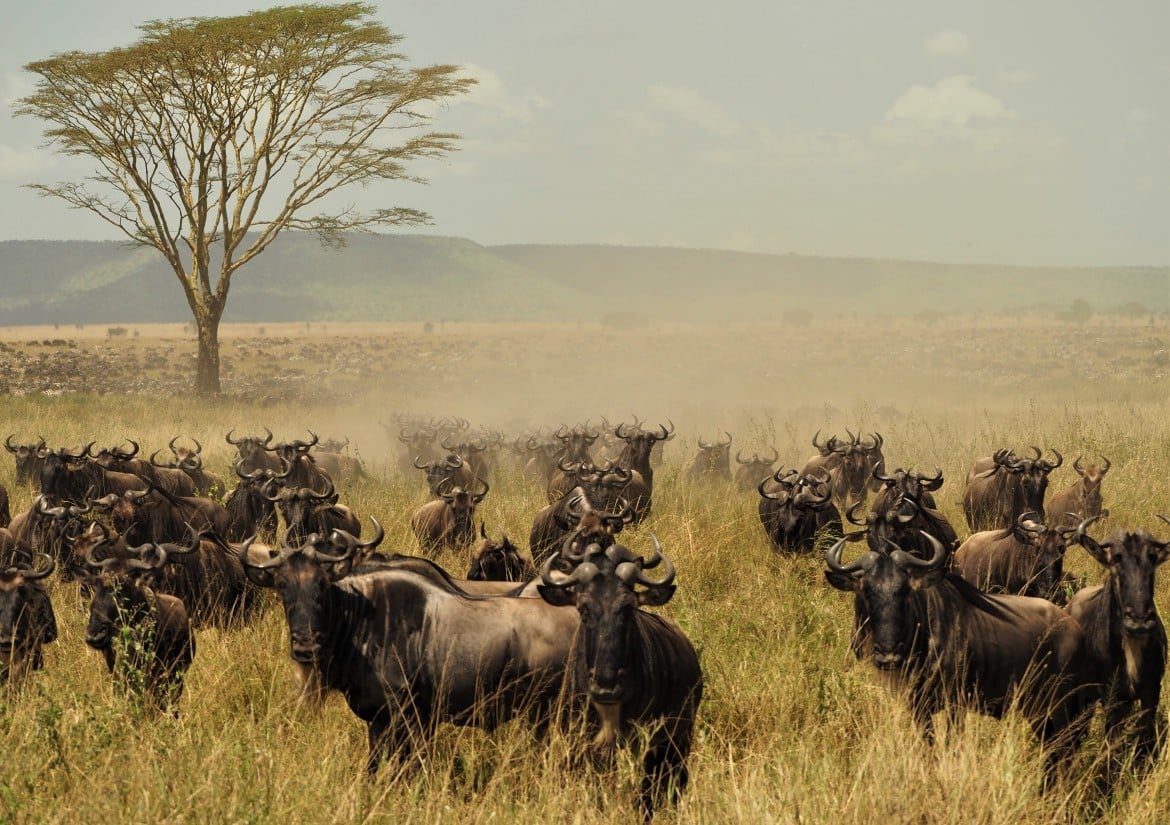
Witnessing the greatest show on Earth, the Serengeti’s wildlife spectacle, is undeniably awe-inspiring. However, many visitors overlook the other incredible experiences Serengeti National Park has to offer. Here are some examples:
The culture within Serengeti National Park is as rich as its wildlife, influenced by the native tribal communities that have inhabited the area for centuries. The Maasai people, one of the most famous indigenous communities, are renowned for their long-preserved culture. The pastoralist Maasai communities live in the eastern region of the Serengeti ecosystem, including the Narok district and the Lolindo area. The Maasai have maintained their traditional way of life, symbolizing Serengeti and Tanzania’s culture. You can experience their unique lifestyle on Serengeti safaris.
A safari in Serengeti National Park isn’t complete without meeting the charming Maasai people. Cultural tours in Tanzania allow you to immerse yourself in the fascinating way of life of these noble communities. You’ll have the opportunity to visit traditional bomas (village huts known as manyattas), and perhaps even a local school or clinic. Additionally, you can participate in activities such as the Maasai cultural dances, also known as the dance of seeing tomorrow.
The Maasai people have lived in harmony with the wildlife and the surroundings of the Serengeti for years, continuing this tradition to this day. While they have adapted to modern advancements, they still honor their traditional way of life. Today, the Maasai engage in trading crafts, growing crops, enhancing their skills, and collaborating with Tanzania’s tourism sector. Many Maasai now work as drivers, trackers, guides, and cooks, helping to generate revenue for the government and providing training opportunities for the younger generation.
Protecting the natural ecosystem for future generations is of utmost importance. Conservation efforts ensure the survival of wildlife, and tourism plays a crucial role in raising international awareness and preventing illegal poaching. All national parks in Tanzania are managed by TANAPA (Tanzania National Parks Authority). In the Serengeti, TANAPA works closely with the Serengeti Conservation Project organization, dedicated to preserving the park’s rich natural heritage and providing secure breeding grounds for its diverse flora and fauna.
Ecotourism is on the rise in Tanzania, and TANAPA is committed to low-impact, sustainable visitation to protect the natural environment. This includes closely monitoring human activities, regulating development, carefully disposing of waste, and managing visitor facilities to minimize the human footprint on the environment.
These combined efforts ensure that the Serengeti remains a pristine and protected natural wonder for generations to come.

Game viewing across the Serengeti’s landscapes is primarily done on game drives, giving you a front-row seat to the Great Migration and close-up encounters with wildlife from a 4WD safari vehicle. Understanding the different private concessions in the Serengeti is essential for optimal game drives, as each safari area offers its unique experiences.
Morning hot air balloon safaris offer an exhilarating adventure, providing panoramic views of the Serengeti from above as the sun rises.
For those seeking more, explore our range of other fantastic safari itineraries through Tanzania Safari Tours and discover a world of possibilities.
After your game drive, you’ll return to your accommodations, reflecting on the day’s adventures. The dusty roads you traveled tell a story, one you’ll remember whenever you encounter a particle of dust in your life.
The land of the Serengeti can be a blend of wilderness and comfort. A crisp linen king-size bed? For sure! A viewing balcony to see the animals crossing by? You have it! Mouth-watering delicacies served under the starry night skyline? This is the place!
We’d love to help you set up a base away from home that offers experiences that will be everlasting. So, the following are some recommendations about Serengeti Accommodations:
This is a great choice for budget travellers and backpackers looking to experience the authentic natural wonder of the Serengeti. The camp is created to offer great amenities while you relax in the comfort of your tented lodging.
There are night bushfires set up outside the camp as well. This is where you can unwind while gazing at millions of stars in the clear skyline of the Serengeti.
Just a notch above the budget choices, this camp may be light on the ground, because it’s eco-friendly, but it’s high on experience. This Serengeti Green-tented camp offers brilliant amenities. Such as non-stop safari adventures, stunning natural sceneries, sundowners and bush dinners.
This is probably one of the most magnificent safari lodges in the savannahs of the Serengeti. If you’re looking for a top-of-the-line luxury safari lodge, then venture no further, this is it right here! The lodge sits right next to a large watering hole where several animals gather in all four seasons.
So, enjoy sundowners on your deck and spot a family of elephants drinking water and bathing. Or satisfy the adventurist in you and go on game drives and hot air balloon safaris. Whatever you’d like to do, a refreshing spa will be waiting where you can re-energize yourself for the next adventure.
| Budget Accommodations | Budget Accommodations |
| Embalakai Authentic Camp | Ang’ata Serengeti Camp |
| Serengeti Safari Lodge | Serengeti Wild Camp |
| Tanzania Wild camps | Bougainvillea Group |
| Tanzania Bush Camp | Tortillis |
| Midrange Accommodations | Midrange Accommodations |
| Serena | Acacia Camps |
| Karibu Camps | Sopa Lodge |
| TWC | Wayo Africa |
| Luxury Accommodations | Luxury Accommodations |
| Lemala | Nimali |
| Asilia | &Beyond |
| One Nature | Four Seasons |
| One Nature | Four Seasons |
| Elewana | Melia |
| Wellworth |
The Serengeti is a land of breathtaking landscapes, diverse wildlife, and luxurious accommodations. Whether you’re a couple, a family, a group of friends, or a solo traveler, this iconic safari destination has something for everyone. Below are some of the major highlights of a Serengeti safari:
These are just a few of the unforgettable experiences awaiting you in the Serengeti. Add this breathtaking destination to your bucket list and create memories that will last a lifetime!
Serengeti National Park is situated in the northern section of Tanzania. It’s located entirely in the eastern Mara region and the northeastern area of the Simiyu region.
Almost all the safaris to the Serengeti start from the town of Arusha. The best way to get to Arusha is by flying into Kilimanjaro International Airport (JRO). From there the town is just 45 km. away.
An alternative option is to fly into Julius Nyerere International Airport (DAR), in Dar es Salaam and then fly to Kilimanjaro International Airport (JRO) or Arusha Airport (ARK).
https://www.taa.go.tz/airports/arusha-airport
One of the major aspects that makes the Serengeti renowned across the world is the Great Wildebeest Migration.
This is indeed a great race for life, in the most untamed yet beautiful form.
Serengeti National Park is renowned across the globe for its massive concentration of wildlife.
The park is home to several species of big cats, countless herbivores, the Great Wildebeest Migration, all of the big five (buffalo, rhino, elephant, leopard, and lion), and over 500 species of birds. Rest assured, you’ll have a fantastic time in the Serengeti if you’re a wildlife enthusiast.
Here are the testimonials from our delighted clients who experienced the trip of a lifetime during their visit to Tanzania: